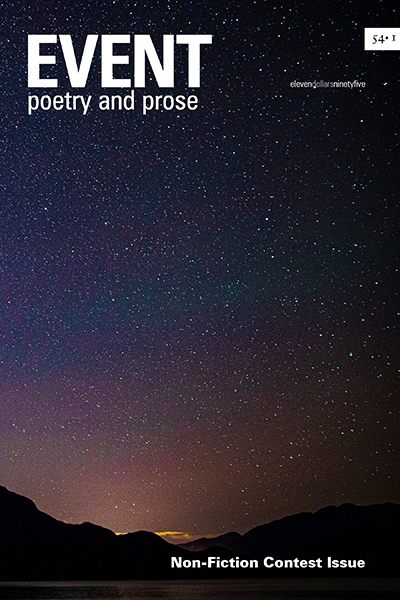Avery Qurashi Reviews Novels from Nina Munteanu and Doreen Vanderstoop for EVENT 49/3

Avery Qurashi Reviews:
Nina Munteanu, A Diary in the Age of Water, Inanna Publications, 2020
Doreen Vanderstoop, Watershed, Freehand Books, 2020
‘How strange […] to feel love and pride for a dying world.’ Thus muses Willa, the protagonist of Doreen Vanderstoop’s Watershed, as she takes in the sight of a drought-ridden agrarian landscape near her beloved family home.
As the climate crisis continues to unfold and each arriving season sheds new light on the ways in which human activity is detrimentally reshaping terrestrial ecosystems, the question of how we relate to a warming, deforested and polluted planet becomes increasingly pertinent. How do we ‘feel love and pride’ for a world full of eroding soil, bleached coral reefs and great garbage patches? And how does this love translate into our treatment of the Earth and willingness to take action against environmental degradation?
Just as author and ecologist Nina Munteanu paints a portrait of a world transformed by climate change in A Diary in the Age of Water, storyteller Doreen Vanderstoop uses speculative fiction to explore environmental degradation, water privatization and human relationships with nature in a post-apocalyptic world. At first glance, A Diary in the Age of Water and Watershed, both published in 2020, appear to be engaged in similar projects and seem to go about communicating their environmentalist messages through similar storylines. Ultimately, however, these two narratives differ both in their scope and in their orientations toward the natural world. While both books forewarn against the dangers of continuing ecological recklessness, Munteanu uses multiple temporal settings to show us a future in which there is eventually little room for human life, whereas Watershed serves as a story of climate resilience, showing us a story of compromise and poignant hope in the midst of slow catastrophe.
Both novels take place in the not-so-distant future in a Canada that the reader can likely recognize, but which has been rendered eerily unfamiliar after several decades of political inaction and resulting ecological destruction, with the bulk of Munteanu’s novel set in Toronto between 2045 and 2066, and Vanderstoop’s story set in various locations across Alberta in 2058. Each of the two novels revolves around a nostalgic middle-aged settler protagonist who serves as the generational bridge between her venerated and deceased single parent and her wilful grown-up child who takes an unusual approach to pursuing environmental justice.
Lynna, the ecologically minded but politically cautious journal-keeper in A Diary in the Age of Water, is a researcher of inland water systems who finds herself working for CanadaCorp, a privatized entity that has largely replaced the role of government in Canada. Through the viewpoint that her CanadaCorp role at the University of Toronto offers, Lynna is able to develop a critical disposition toward a cultural climate that makes possible unimaginably tight restrictions on water usage. With a belief that a mother’s outspokenness can pose a threat to her child’s well-being, Lynna refrains from speaking out about environmental degradation in order to protect her daughter, but as young Hilde grows up, Lynna watches in fear as her daughter becomes an avid activist.
A Diary in the Age of Water is ambitious. It brings together discussions of science, politics and spirituality as it plays with different storytelling formats to prophesy an impending apocalypse. Most of Munteanu’s story takes the form of a diary, but the collection of entries often reads somewhat like a field journal, with many pages chock-full of ecological information, and complete with a bibliography and catalogue of scientific diagrams. Within Lynna’s journal, Munteanu presents her readers with an interdisciplinary environmentalist glossary, giving each entry an epigraph with borrowed definitions of concepts ranging from ‘HYDROLOGICAL CYCLE’ to ‘ANTI-INTELLECTUALISM.’ Quite appropriately, within the context of Munteanu’s larger story, Lynna’s diary is treated as a historical document, shelved next to a famous geological textbook in a library. In its determined effort to portend a dystopian eco-political future while providing its readers with a comprehensive environmental education, Munteanu’s novel reads almost as though it were a well-researched thesis project for a highly creative and keen environmental science student.
A key part of what makes A Diary in the Age of Water so ambitious is its investment in Canadian national identity and its aim to address the nation as a whole. Writing a diary entry in the year 2054, Lynna laments, ‘Canada was once renowned for its untouched wilderness and pristine water—before we gave them away.’ A familiar caricature of Canadian identity appears when Lynna attributes Canada’s water scarcity to its tendency to be ‘so darn polite,’ as Munteanu’s futuristic Canada allows the United States and China to extract ‘surface water, groundwater, ice, and other resources.’ In her analyses of North American politics, Lynna repeatedly uses a schoolyard-bullying metaphor to characterize the relationship between Canada and the US and frames Justin Trudeau as Canada’s ‘bastion of liberty’ who falls victim to an elaborate American water-theft plot. While A Diary in the Age of Water works to present Canada as friendly and tolerant, it is strangely invested in producing and protecting a coherent image of Canadian national identity to such a great extent that it occasionally comes across as xenophobic, as Lynna’s journal entries continually villainize American characters and frame China as both an ecological and cultural threat to Canada.
As we see echoed in Vanderstoop’s Watershed, Munteanu’s Diary presents place-based identity as something that is intimately tied to the surrounding landscape and the way in which a place’s inhabitants relate to their environment. Lynna mourns the loss of pristine wilderness because for her being Canadian means being in tune with Canada’s ‘vast treasure of diverse ecosystems’ such as the ‘wild and majestic’ boreal forest.
With a focused emphasis on the cultural and ecological environment of Alberta, Watershed takes a different approach as it forecasts the ways in which glacial melting will detrimentally transform life in Alberta.
On her goat farm near Fort MacLeod, bone-weary Willa works with her husband to keep their herd alive, care for their late neighbours’ teenage son and stay financially afloat in times of hardship for folks in parched and disease-ridden southern Alberta. Watershed closely follows not only Willa but also her distant son Daniel, who has seemingly abandoned his rural roots to pursue more high-profile success. Daniel works for Crystel, the company that manages Alberta’s water and receives constant threats from militant northern Albertan opponents of its proposed water pipelines that promise to quench the soils of the south. In keeping with the key motif that Margaret Atwood identifies in her famous 1972 guide to CanLit, Willa and Daniel’s stories are narratives of survival. They come together gracefully in Vanderstoop’s captivating story of home.
Less explicitly educational than Munteanu’s novel, Watershed takes a more traditional format, but still provides an illustrative model of an environmental ethic from which we might learn how to more carefully conduct our lives as we interact with a changing planet. Watershed provides us with two contrasting portraits of nature that both differ from the unsullied boreal wilderness for which Lynna grieves in Diary. Visiting a wealthy relative in northern Alberta, Willa encounters a manicured natural environment where ‘Everything’s been planted and trained and preened and pruned,’ which, despite its lush appearance, prompts her to long for the ‘spindly, bony lodgepole pines’ back on her dusty, wind-battered family farm. Willa communicates her affection for an imperfect natural environment with the simple phrase, ‘It’s no Eden, but it’s home.’ Watershed presents a bleak social and environmental future for Alberta, but it is one in which there is still room for human life, and one that fosters kinship between people and place even within ‘a dying world.’
Differences between the environmental messages that Watershed and A Diary in the Age of Water present reflect a tension with which contemporary environmentalists must grapple. While both books present unsettling portraits of ecological dystopias that may incite us to mitigate the disasters they predict, Munteanu’s Diary highlights the urgency of the climate crisis by creating a fictional future wherein humanity’s survival is juxtaposed with the planet’s, whereas Vanderstoop’s Watershed provides a blueprint of how we might struggle and survive as beings that are part of a slowly dying natural world.
—Avery Qurashi













